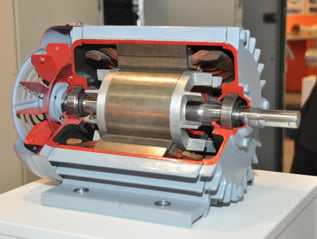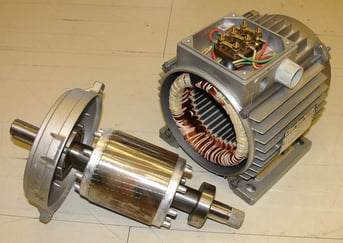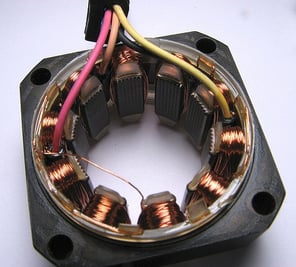This is the first post in a series of upcoming posts on Industrial Automation 101 topics.
These posts are geared towards people new to the industry who are looking for basic information on how some of the gear in the industrial automation field works, when to use it, and maybe even how to troubleshoot it here and there.
Subscribe to the Opto 22 blog to receive new posts as they become available.
And if you’re an industry pro and want to leave a few tips and tricks of your own, feel free to leave them in the comment section below. We may just incorporate them into the blog and give you and your company credit for them.

If you’re new to the automation space, one piece of technology that you’ll want to quickly get up to speed on is the AC motor. AC motors do a lot of the heavy lifting in many industrial automation applications.
They convert AC electrical energy into mechanical energy, which produces a mechanical rotary action that does some form of work. AC motors are the most common types of motors used in commercial and industrial applications.
I once read an article that claimed roughly half of the electricity generated in the US was used to power AC motors.
Many types of AC motors are used in industrial applications. But without a doubt, the workhorse of modern industry is the standard AC induction motor. So that’s what we’ll focus on in this post.
AC induction motors
So what’s an AC induction motor and how does it work?
An induction motor is a type of AC motor where power is supplied to a rotating shaft by means of electromagnetic induction.
AC induction motors have two basic electrical parts:
- Rotor (the part that rotates)
- Stator (the part that generates the magnetic field that drives the rotor)

AC motors function based upon the principle of having polarities within a rotating magnetic field. If you were to crack open an AC motor, inside you’d find stationary electromagnetic coils or staters positioned around a movable magnet, called the rotor.
The stator is made up of layers of iron that are stacked together in such a way that they form an electromagnet with a hollow cylinder in the middle.
One pole of each magnet faces toward the center of the group. Copper wire is then wound clockwise and counterclockwise around the poles to create coils that face the center of the electromagnet.
When current flows through the the coils, they form a North and South pole pair and create a directional flux. The direction of the flux depends on the current and winding direction of each coil. The magnet's polarity changes every half cycle of the AC power supply, creating an alternating magnetic field.

The rotor is the rotating electrical component, and it's located inside the hollow cylinder of the stator, which is stationary. The rotor consists of magnets arranged around a cylinder, with the poles facing toward the stator poles.
As the magnetic field of the stator alternates with the frequency of the AC power supply, the rotor is naturally attracted to the magnetic field and follows the stator direction, causing the rotor to spin.
The speed of an AC motor is typically determined by how many cycles of alternating current it receives each second. For example, here in the U.S. our electrical grid runs at 60 Hz.
Benefits of AC induction motors
AC induction motors have many beneficial traits, including:
- Very low maintenance; extremely reliable. This is especially true in the case of the squirrel-cage induction motor, as there are no brushes or slip-rings (DC motors and synchronous motors both require brushes, which wear out).
- Approximate constant speed (dependent on the motor slip) at no-load and full load. Motor slip is the difference between the synchronous speed of the magnetic field of the stator and the rotor shaft's rotating speed. Motor slip increases with an increasing load, thus providing a greater torque.
- Relatively inexpensive to manufacture.
What's Next?
Now that we know how a basic AC induction motor works, in a followup blog post we’ll talk about how to wire an AC induction motor up to a SNAP control system. We'll also look at some basic troubleshooting steps if your motor isn’t working.
And finally, we’ll take it a step further and spend some time talking about how to add some predictive analytics capabilities to your average run-of-the-mill AC motor.

